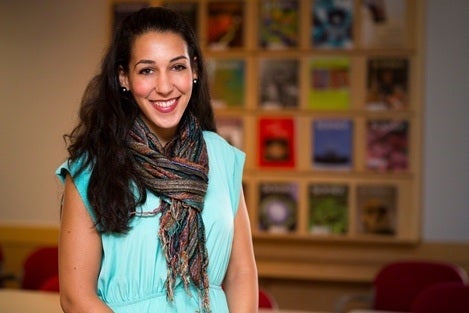June 6, 2014 — With a bachelor’s degree in mathematical biology, Nadia Abuelezam once considered herself a mathematician who used her skills to tackle public health problems. But after five years as a doctoral student at Harvard School of Public Health (HSPH), she no longer identifies herself as a numbers person first: “I think I’m an epidemiologist at heart,” she says.
Abuelezam, who studied both pure and applied mathematics during her undergraduate years at Harvey Mudd College in California, graduated from HSPH in May with a doctor of science in epidemiology.
An introduction to HIV
Between her junior and senior years of college, Abuelezam took advantage of an opportunity to travel to Uganda to work with The AIDS Support Organization. The work was described as an IT project to improve the organization’s information-storing capacity as it transitioned from paper to electronic medical records. But after arriving in Uganda, she discovered the organization had a greater need for hands-on help with direct services, and her visit turned into a crash course in the field of public health. Abuelezam counted antiretroviral therapy pills in a pharmacy, traveled to villages for HIV testing days, and sat in on counseling and group therapy sessions with patients. It was a “transformative and formative introduction to HIV,” she said.
An undergraduate professor had introduced her to her research in mathematical modeling of cancer proliferation; from her she learned that her mathematics background could be applied to public health. Upon her return to the U.S., she chose to write her undergraduate thesis on how best to distribute HIV treatment in Uganda—using a mathematical model, of course.
A first-generation college graduate, Abuelezam’s parents raised her to value education and aim high. So she decided to pursue a doctorate and chose to study epidemiology, a field in which she could apply the quantitative rigor of her mathematics background to studying HIV transmission and prevention. She was attracted to HSPH partly because of the work of Marc Lipsitch, a researcher doing work on infectious disease modeling, and the School’s Center for Communicable Disease Dynamics, which Lipsitch directs.
Simulation model
For her dissertation, Abuelezam helped create a mathematical model, the CEPAC Dynamic Model (CDM), that simulates an entire population’s sexual network—“like a SimCity world,” she says—in order to project how long it would take to eliminate HIV in South Africa.
Abuelezam’s current plans are to remain at HSPH as a postdoc and continue to work on the CDM. She hopes to use it not just for long-term projections, but to address more immediate issues for the HIV community, such as simulating combination prevention trials. She would also like to pursue what she calls her “brave project” of addressing HIV in the Middle East. “It’s a very taboo topic. Many governments in the region refuse to recognize they have any sexually transmitted diseases or HIV in their country,” said Abuelezam. Creative solutions will be necessary to work in this region, she said, and she imagines starting with anonymous surveys online.
In the long-term, she envisions taking the faculty track for her career path, not only to advance her research but because she wants to teach and mentor students. She appreciates HSPH Dean Julio Frenk’s belief that the School’s function is not just the production of knowledge through research, but also its reproduction through teaching and its translation into policy and practice. “I honestly believe education is the solution to every major problem in the world. If you’re not able to communicate the knowledge you produce to others, what’s the point of doing the research?” said Abuelezam.
photo: Mike Mazzanti
